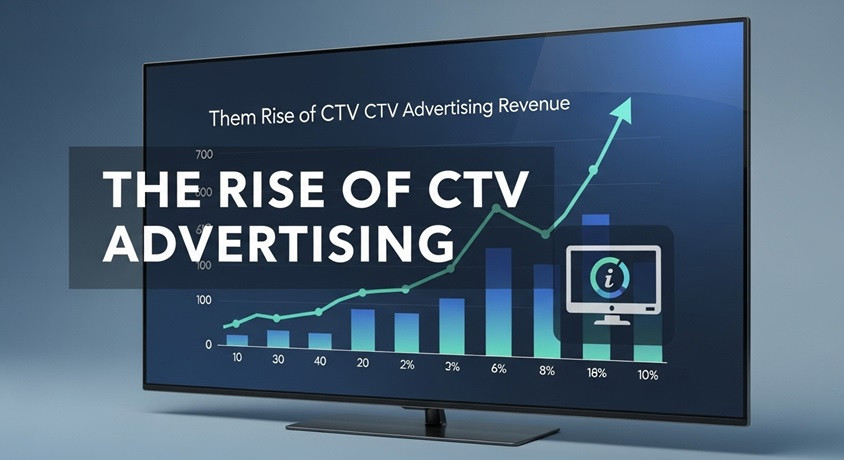The Rise of CTV Advertising: Key Trends, Stats, and Strategies for Marketers
The way people consume television has changed dramatically over the past decade. Traditional cable TV is no longer the dominant force it once was, as viewers increasingly shift to Connected TV (CTV) platforms. This shift has opened up a massive opportunity for advertisers to reach engaged audiences in a highly targeted, measurable, and effective way.
In this blog, we’ll explore what CTV advertising is, why it’s growing so rapidly, key statistics that highlight its impact, and how marketers can leverage it for maximum ROI.
What is CTV Advertising?
Connected TV (CTV) refers to any television that can stream video content via the internet, either through smart TVs (like Samsung, LG, or Roku TVs) or external devices like Amazon Fire Stick, Apple TV, or Google Chromecast. CTV advertising involves delivering video ads to viewers on these internet-connected platforms, often through apps like Hulu, YouTube, Netflix (with ads), Disney+, and more.
Unlike traditional TV advertising, CTV allows for precise targeting, real-time performance tracking, and interactive ad formats—making it a powerful tool for modern marketers.
Why CTV Advertising is Growing Rapidly
The growth of CTV advertising is fueled by several key factors:
Cord-Cutting Trend – More consumers are canceling cable subscriptions in favor of streaming services.
Increased Streaming Options – The rise of ad-supported streaming tiers (like Netflix with ads, Hulu, Peacock) gives advertisers more inventory.
Better Targeting & Measurement – CTV offers data-driven ad placements, unlike traditional TV’s broad reach.
Higher Engagement – Viewers are often more attentive on CTV than linear TV, leading to better ad recall.
CTV Advertising: Key Stats and Insights
Let’s look at some compelling data that highlights the power of CTV advertising:
CTV Adoption: Over 87% of US households now have at least one CTV device, and this number is expected to grow. (Nielsen)
Ad Spend Growth: CTV ad spending in the US is projected to reach $25 billion by 2025, up from $15 billion in 2022. (eMarketer)
Viewer Engagement: CTV ads have an average completion rate of 95%, significantly higher than mobile or desktop video ads. (Tubular Labs)
Ad-Supported Streaming: Nearly 60% of US streaming viewers now use ad-supported platforms, creating more opportunities for advertisers. (Deloitte)
Performance Over Linear TV: CTV campaigns see 40% higher ROI compared to traditional TV due to better targeting and lower waste. (Magnite)
Benefits of CTV Advertising
Precision Targeting – Advertisers can target audiences based on demographics, interests, location, and even purchase behavior.
Measurable Results – Unlike traditional TV, CTV provides real-time analytics on impressions, clicks, conversions, and more.
Non-Skippable Ads – Most CTV ads are unskippable, ensuring higher visibility.
Cross-Device Retargeting – CTV data can be used to retarget viewers on mobile, desktop, or social media.
Brand Safety – Ads appear within premium, vetted content, reducing fraud risks.
Challenges in CTV Advertising
While CTV offers many advantages, there are challenges to consider:
Fragmented Ecosystem – Multiple platforms (Roku, Amazon Fire, Samsung) require different buying approaches.
Frequency Capping – Without proper controls, viewers may see the same ad too often.
Measurement Standards – Industry-wide metrics are still evolving compared to digital channels like social media.
How to Get Started with CTV Advertising
Define Your Audience – Use first-party data or third-party segments to target the right viewers.
Choose the Right Platforms – Focus on where your audience streams (Hulu, YouTube, Roku, etc.).
Optimize Creative – Ensure ads are high-quality, engaging, and tailored for the big screen.
Test & Measure – Run A/B tests on creatives, placements, and CTV vs. other channels.
Leverage Programmatic Buying – Use DSPs (Demand-Side Platforms) to automate and optimize CTV ad buys.
The Future of CTV Advertising
As streaming continues to dominate, CTV advertising will only grow more sophisticated. Expect advancements in:
Interactive Ads – Shoppable TV ads that let users purchase directly from their screens.
AI-Driven Personalization – Hyper-targeted ads based on real-time viewer behavior.
More Ad-Supported Streaming – Even premium platforms will introduce ad tiers to capture revenue.
Final Thoughts
CTV advertising represents the future of TV marketing, combining the reach of traditional TV with the precision of digital advertising. With its high engagement rates, advanced targeting, and strong ROI, it’s no surprise that brands are shifting budgets toward CTV.
Marketers who embrace CTV now will have a competitive edge as the landscape evolves. Whether you’re a small business or a global brand, CTV offers scalable opportunities to connect with audiences in a meaningful way.


